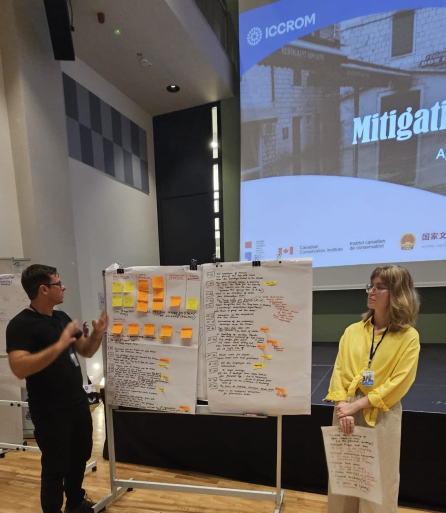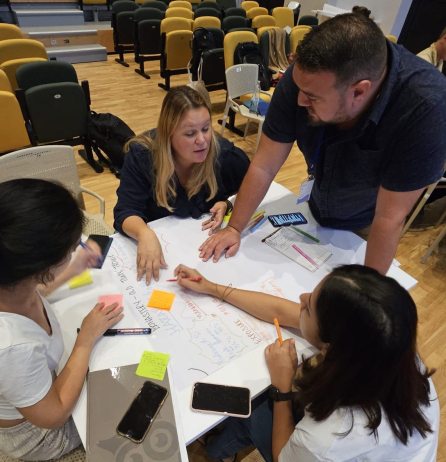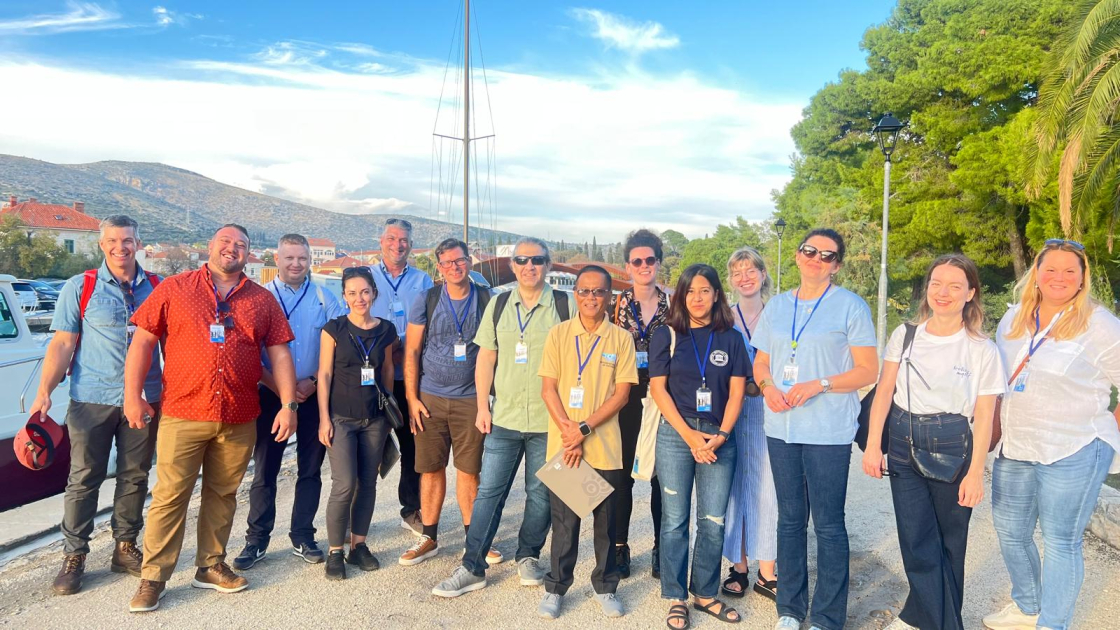El curso “Mitigación del riesgo de inundaciones para el patrimonio cultural” marca un importante avance en la salvaguarda de diversas tipologías de patrimonio frente a los riesgos de inundación.
Del 22 al 30 de septiembre de 2024, el programa Primeros Auxilios y Resiliencia para el Patrimonio Cultural en Tiempos de Crisis (FAR) del ICCROM organizó en Trogir, Croacia, un curso híbrido sobre mitigación del riesgo de inundaciones. El curso fue organizado en colaboración con el Ministerio de Cultura y Medios de Comunicación de la República de Croacia, con el generoso apoyo del Instituto Canadiense de Conservación (CCI) y de la Administración Nacional del Patrimonio Cultural de China. Reunió a 14 participantes de seis países -Canadá, Croacia, Malta, India, Polonia y Rumanía-, todos ellos enfrentando riesgos inminentes de inundación, exacerbados por factores como el cambio climático y la urbanización.
Las inundaciones se han convertido en una de las amenazas más graves y frecuentes para el patrimonio cultural a nivel mundial. El curso PREVENT: Mitigación del riesgo de inundaciones para el patrimonio, el segundo de la serie PREVENT tras el éxito del curso de mitigación del riesgo de incendios de 2022, fue diseñado para hacer frente a este creciente desafío. El enfoque de este año, centrado en las inundaciones, destaca la necesidad urgente de una acción colectiva e inmediata para proteger todas las formas de patrimonio.
A través de la serie PREVENT, buscamos fomentar la colaboración entre profesionales de distintos sectores, proporcionándoles formación especializada y recursos para enfrentar los desafíos específicos de la gestión del riesgo de inundaciones en sus regiones. La capacitación enfatiza la comprensión de los factores que contribuyen a los riesgos de inundación, así como en la implementación de estrategias de mitigación rentables y planes de preparación para emergencias en sitios patrimoniales.
Una experiencia colaborativa de aprendizaje
Antes de la sesión presencial, los participantes completaron una orientación en línea que abarcaba conceptos fundamentales como la relación entre desastres y cambio climático, los componentes de la evaluación de riesgos, y estudios de caso globales que ilustran el impacto del cambio climático en el patrimonio cultural.
Durante la semana de formación, los participantes asistieron a sesiones teóricas y simulaciones prácticas. Se centraron en la evaluación de riesgos de inundación en sitios patrimoniales, el análisis de vulnerabilidades y la elaboración de escenarios de riesgo. El curso también destacó el valor del conocimiento tradicional, las estrategias lideradas por las comunidades y las respuestas de emergencia ante inundaciones en sitios patrimoniales. Al finalizar el curso, cada equipo elaboró un plan de acción detallado para mitigar los riesgos de inundación específicos de sus sitios patrimoniales o instituciones.
Principales aspectos del curso
El curso fue inaugurado oficialmente por la directora general del ICCROM, Aruna Francesca Maria Gujral, junto a Tomislav Petrinec, director de la Dirección de Protección del Patrimonio Cultural del Ministerio de Cultura y Medios de Comunicación de Croacia, y el alcalde de Trogir, Ante Bilić. Todos destacaron la urgente necesidad de una gestión proactiva del riesgo para salvaguardar el patrimonio frente a fenómenos meteorológicos extremos.
El programa incluyó una mesa redonda de alcaldes para discutir los riesgos actuales de inundación en Trogir, los planes de gestión existentes y las brechas en la protección del patrimonio. Este diálogo puso de manifiesto los retos que enfrentan las ciudades históricas y la necesidad de adoptar medidas de protección del patrimonio más sólidas.
Principales lagunas identificadas
- A pesar de que el patrimonio cultural está reconocido en diversos documentos estratégicos nacionales, persiste una importante brecha en su implementación efectiva sobre el terreno, especialmente en cuanto a la cooperación intersectorial e interinstitucional.
- Las pérdidas económicas provocadas por las inundaciones superan con creces las inversiones destinadas a la resiliencia.
- La cooperación entre el sector del patrimonio cultural y las comunidades científicas del clima es limitada, al igual que la colaboración entre distintos niveles de autoridad y sectores.
- La escasa concienciación sobre los riesgos de inundación y las estrategias de resiliencia entre los responsables de la toma de decisiones obstaculiza una acción eficaz.
- La insuficiencia de datos impide evaluar y valorar correctamente los riesgos de inundación.
- La subestimación de los riesgos y las pérdidas asociadas a las inundaciones da lugar a la percepción de que los esfuerzos de mitigación son innecesarios.
Directrices para soluciones
Para abordar estas cuestiones clave, se propusieron las siguientes soluciones:
Adoptar la innovación: incorporar tecnologías tanto nuevas como tradicionales.
Transformar el comportamiento institucional: fomentar una cultura de colaboración y comunicación interinstitucional.
Crear modelos empresariales sostenibles: revisar los procesos de planificación urbana y rural para priorizar la resiliencia.
Garantizar una gestión eficiente de los recursos: optimizar la asignación de recursos para maximizar el impacto.
Promover la investigación y la innovación: invertir en estudios sobre resiliencia climática y conservación del patrimonio cultural.
Aprovechar el conocimiento tradicional: integrar los saberes y prácticas locales en las estrategias modernas de resiliencia.
Educar y sensibilizar: desarrollar programas educativos, especialmente dirigidos a los jóvenes, para fomentar una cultura de preparación y conciencia.
Integrar el patrimonio cultural en la planificación estratégica junto con la climatología, a todos los niveles.
Ofrecer formación en gestión de riesgo de desastres: capacitar a las autoridades locales y comunidades para mejorar la preparación.
Establecer una normativa sólida: desarrollar un marco regulatorio sólido que respalde los esfuerzos de mitigación del riesgo de inundaciones.
Diseñar políticas locales específicas: diseñar políticas locales específicas adaptadas a las necesidades y vulnerabilidades del territorio.
Nombrar un coordinador nacional: designar un responsable nacional que supervise y articule los esfuerzos de gestión del riesgo de inundaciones.
Círculo de historias con un pescador de la isla de Ugljan: Integrando el conocimiento tradicional en la gestión del riesgo de inundaciones
Como reflejo del compromiso del curso con los enfoques centrados en la comunidad, se organizó un círculo de historias con Bozidar Blaslov, pescador de la isla de Ugljan (Croacia). El objetivo de esta sesión fue incorporar las voces de las comunidades pesqueras en primera línea a la conversación sobre gestión del riesgo de inundaciones. Los pescadores como él han conservado durante generaciones conocimientos valiosos sobre los patrones meteorológicos y la previsión de tormentas, que emplean para planificar sus actividades pesqueras y mitigar riesgos.
Compartió los métodos tradicionales que su comunidad utiliza para prepararse ante tormentas y cambios meteorológicos. Estas prácticas, transmitidas de generación en generación, subrayan el valor del conocimiento local en la gestión del riesgo de inundaciones. Los participantes se sintieron inspirados para explorar enfoques comunitarios similares en sus propios contextos patrimoniales.
Evaluación de vulnerabilidad y capacidad en Trogir: involucrando a la comunidad local en la gestión del riesgo de inundaciones
Los participantes realizaron una evaluación participativa de vulnerabilidad y capacidad (VCA), utilizando la herramienta inSIGHT del ICCROM-FAR. La actividad contó con la participación de más de 35 miembros de la comunidad local, incluyendo comerciantes, niños y funcionarios. Esta experiencia subrayó la importancia de integrar el patrimonio cultural en la planificación del riesgo de inundaciones, garantizando que las voces locales guíen la toma de decisiones y refuercen la resiliencia comunitaria.
Simulación final basada en escenarios
Una simulación de inundación en el Monasterio Benedictino de Trogir, utilizando visualizaciones en 3D y recorridos interactivos permitió, a los participantes vivir una experiencia de aprendizaje inmersiva y aplicar los conocimientos adquiridos en contextos reales de respuesta ante inundaciones. Este ejercicio puso de relieve la importancia de la comunicación y la colaboración eficaz entre los actores clave durante las emergencias. Las intervenciones del alcalde de Trogir y del cuerpo de bomberos local reforzaron el papel clave del trabajo en equipo y coordinación para proteger el patrimonio cultural en tiempos de crisis.
Mirando hacia el futuro
aprendidas en este curso resonarán más allá de las fronteras, garantizando que el patrimonio permanezca protegido para las generaciones venideras. Durante los próximos seis meses, los participantes revisarán e implementarán sus planes de acción para mitigar los riesgos de inundación en sus respectivos sitios. Se les animará a compartir sus experiencias y resultados con sus comunidades y redes locales, amplificando así el impacto de la formación. Si seguimos implicando a las partes interesadas y promoviendo la concienciación sobre los riesgos de inundación, podemos construir colectivamente un enfoque más resiliente para la conservación del patrimonio.






